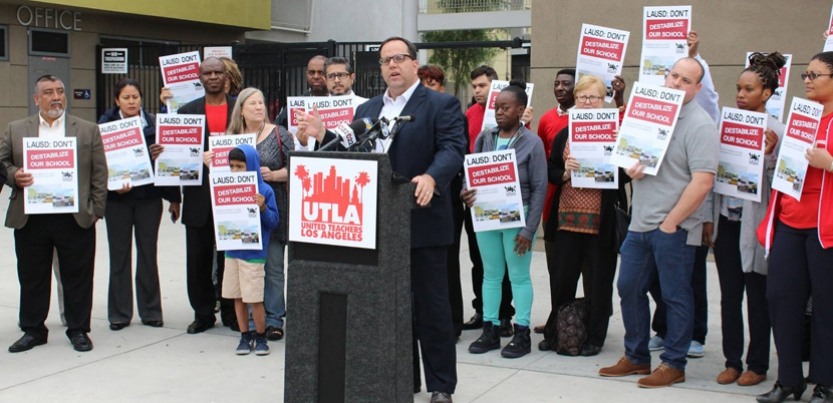Building a Team to Win Local Union Office

After winning leadership of United Teachers-Los Angeles, the Union Power coalition ran a vigorous contract campaign. Photo: UTLA
Are you thinking about running for local union office?
If you’re like most candidates, you start by asking “Who can I get to run with me?”
It seems like a good question. But it’s the wrong way to start your campaign.
What if one of the people on your slate turns out to be a dud? What if you meet new people who are better for the job or help you reach new voters?
That’s why filling out your slate early usually isn’t the best idea.
Besides, if you’re in a big local, you’re going to need a broad group of supporters helping you turn out the vote. You can’t do that alone—even with your entire slate campaigning hard.
A better place to start is by building a broader team of members who will help you campaign, and pick your slate later in the game.
If you’re running for office, you know what a big commitment the union can be: all the meetings, the early mornings, the late-night phone calls.
Most members aren’t willing to be as committed as you are. They won’t give up their weekends for the union. They won’t wake up early to go hand out flyers.
That’s OK. Even though most members won’t commit as much as you do, some members are willing to do something.
Your job is to bring together the people who are willing to do a lot, and work with them to organize and mobilize the members who are willing to do a little.
YOUR CORE TEAM
Your core team is made up of the people who will distribute campaign leaflets, shirts, and stickers. They’ll collect email addresses and phone numbers, sell raffle tickets, and phonebank members. They’ll show up to important campaign events and come to some campaign meetings.
Ideally, your core team is bigger than your slate. Without this inner circle, you’ll end up doing most of the campaign work yourself, and your campaign will suffer.
ACTIVE SUPPORTERS
There are usually many more members who won’t come to many meetings, but who will help out where they work.
From the get-go, you want to recruit active supporters in key buildings and locations where you need votes. They can talk to other members about the campaign and introduce you to members when you’re campaigning at their building. You can ask them to identify issues where they work and tell you who supports you in their shop. They should pass out flyers and wear campaign buttons and shirts. You should use their picture and a quote endorsing you in campaign flyers.
When the ballots are out, your active supporters can help you get out the vote across your local.

SUPPORT LABOR NOTES
BECOME A MONTHLY DONOR
Give $10 a month or more and get our "Fight the Boss, Build the Union" T-shirt.
It’s hard to get members involved in our unions. So how do you get them involved in your campaign?
Make member-to-member contact the heart of your campaign. The most powerful organizing tool is talking to members one on one. Petitions, websites, and flyers are tools for getting people to talk member to member. They’re no substitute.
Here’s some more tips:
Map your local. Identify key shops and potential leaders. Then make a plan for getting those potential leaders more involved.
Start small. Don’t overwhelm someone, especially when you are first trying to get him or her involved.
Make specific requests with a definite beginning and end. They’re less intimidating. “Can you meet me from 7:30 to 9 to pass out leaflets next Wednesday?” is better than “We need people who will help us reach other members.”
Ask people to do things they do well—especially at first. As their confidence grows, so will their participation.
Tell each person how their job fits in with the rest. “Our goal is to reach members in every building with this leaflet in the next week. We have members covering A, B, and C locations. Can you cover D by Friday?”
Hold regular meetings for your core group. But don’t confuse meetings with activity.
Ask supporters who can’t come to meetings to help. More people will help you where they work than will come to your meetings.
Respect abilities and boundaries. Try to get people to take on more responsibility and get more involved, but remember not everyone will participate the same amount or in the same way.
Don’t give up on people. If some members are potential assets to your campaign, keep talking to them and asking them to get involved. One “no” doesn’t mean “never.”
There’s a lot to think about when picking out your slate. Who is respected? Can you build alliances with other groups in the local? Can you build a team that represents the diversity of the local? And a lot more (it’s a whole chapter in our new book).
Answering these questions will be a lot easier after you’ve started building your team and organizing for change in your local.
Excerpted from the comprehensive new guide Running for Local Union Office, from Teamsters for a Democratic Union. Although the book is written for Teamsters, almost all of it will apply in any union election.



